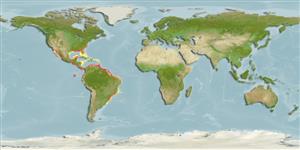Elasmobranchii (sharks and rays) >
Carcharhiniformes (Ground sharks) >
Sphyrnidae (Hammerhead, bonnethead, or scoophead sharks)
Etymology: Sphyrna: Probable misspelling of sphyra (Gr.), hammer, referring to their hammer-shaped heads (See ETYFish); media: Latin for middle, allusion not explained, probably referring to its oculonarial expanse being “roughly intermediate in shape between that of hammerheads [subgenus Sphyrna] and shovelheads [subgenus Platysqualus]” (See ETYFish).
Environment: milieu / climate zone / depth range / distribution range
Ecology
Marine; demersal; depth range 8 - ? m (Ref. 58018). Tropical; 35°N - 34°S, 118°W - 31°W
Western Atlantic: Panama to southern Brazil. Eastern Pacific: Gulf of California to Ecuador and probably northern Peru.
Size / Weight / Age
Maturity: Lm ? range ? - ? cm
Max length : 150 cm TL male/unsexed; (Ref. 5217); common length : 100.0 cm TL male/unsexed; (Ref. 5217)
Little-known. Found in inshore areas over the continental shelves. Viviparous (Ref. 50449). Utilized fresh for human consumption and for fishmeal.
Life cycle and mating behavior
Maturity | Reproduction | Spawning | Eggs | Fecundity | Larvae
Viviparous, placental (Ref. 50449).
Compagno, L.J.V., 1984. FAO Species Catalogue. Vol. 4. Sharks of the world. An annotated and illustrated catalogue of shark species known to date. Part 2 - Carcharhiniformes. FAO Fish. Synop. 125(4/2):251-655. Rome: FAO. (Ref. 244)
IUCN Red List Status (Ref. 130435: Version 2024-1)
Threat to humans
Traumatogenic
Human uses
Fisheries: minor commercial
Tools
Special reports
Download XML
Internet sources
Estimates based on models
Phylogenetic diversity index (Ref.
82804): PD
50 = 0.5029 [Uniqueness, from 0.5 = low to 2.0 = high].
Bayesian length-weight: a=0.00347 (0.00153 - 0.00788), b=3.12 (2.93 - 3.31), in cm total length, based on LWR estimates for this (Sub)family-body shape (Ref.
93245).
Trophic level (Ref.
69278): 4.0 ±0.4 se; based on size and trophs of closest relatives
Resilience (Ref.
120179): Low, minimum population doubling time 4.5 - 14 years (Fec assumed to be <100).
Fishing Vulnerability (Ref.
59153): Very high vulnerability (90 of 100).
